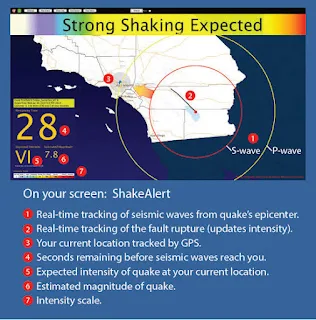"Resilience in the Face of Earthquake Shocks: Northern California's Early Warning System"
People in Northern California were startled out of slumber in the wee hours of the morning by an earthquake of magnitude 4.1. Seismic activity is a constant in this region of the planet, as the incident served as a clear reminder.
Still, the prompt action of the area's sophisticated early warning system makes this incident unique. This piece will explore the earthquake, its effects, and how early warning systems might improve resilience and preparedness.
The Event of an Earthquake
The earth beneath Northern California trembled on a calm morning when most people were still in the embrace of their dreams. The 4.1-magnitude earthquake struck suddenly, alerting the locals to the dangers around them. Even though it might not be considered a significant earthquake, there was still a chance that it would cause harm and destruction. Thankfully, the amazing technological and technical feat known as the early warning system went into effect.
Prompt Alertness in Action
An essential part of the resilience plan for the area is the early warning system. It detects the first, less destructive seismic waves produced by an earthquake using a network of sensors positioned strategically around Northern California. These sensors identify suchwaves, they set off an alert system that notifies officials and locals, allowing them vital seconds to seek shelter and prepare for the more damaging shock waves that will come next.
When the recent 4.1 earthquake occurred, the early warning system worked perfectly. Through a number of communication platforms, such as emergency broadcast systems and smartphones, it sent out alerts. This made it possible for individuals to flee for their lives, shut down vital infrastructure, and suspend public transit. Such prompt actions are essential for reducing the possible harm and damage that earthquakes may inflict.
Increasing readiness and adaptability
An excellent illustration of how technology may significantly improve a region's readiness and resilience to natural catastrophes is the early warning system in Northern California. In a region prone to earthquakes Similar to those in Northern California, these early warning systems have the potential to save lives and vital infrastructure.
The ability of an early warning system to recognize and convey an imminent threat as soon as possible is critical to its effectiveness. Here, the early warning system uses a network of seismometers to identify the P-waves, which are less damaging than the surface waves and S-waves that follow. Through quick data analysis and alerting, it offers a critical window of opportunity for people to take preventative measures.
Instructions for Other Areas
The early warning system in Northern California is a useful example for other earthquake-prone areas in the world. It demonstrates the value of funding the creation and upkeep of these kinds. Although earthquakes cannot be prevented, early warning systems greatly lessen their effects and, most importantly, save lives.
A few crucial components are necessary for this system to succeed:
Sufficient Funding: Sufficient funding is necessary to keep the system operating and maintained continuously.
Public Awareness: It is essential to make sure that the general public is informed about how the system operates and what to do in the event of an alert.
Government Support: To ensure that the necessary infrastructure is in place to respond efficiently, government entities must coordinate the distribution of notifications.
In conclusion, the recent earthquake in Northern California, which measured 4.1 magnitude, acted as a warning about the region's susceptibility to seismic activity. But it also demonstrated the extraordinary tenacity of the neighborhood, supported by a sophisticated early warning system. The event serves as evidence of how well this system works to prevent harm and save lives. It is highly recommended that other areas vulnerable to earthquakes take note of this model and invest in analogous early warning systems in order to fortify their own readiness and fortitude against the capricious fury of nature.88




.jpeg)
.jpeg)
0 Comments